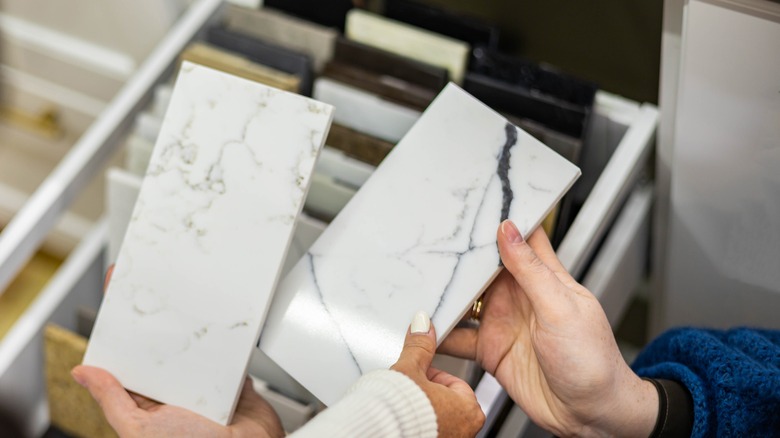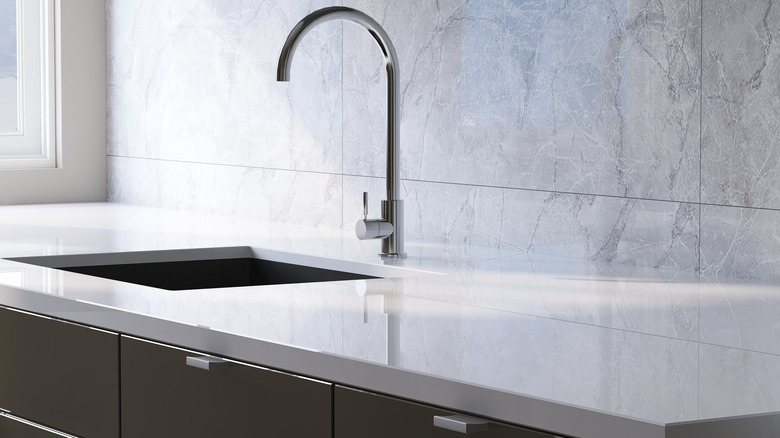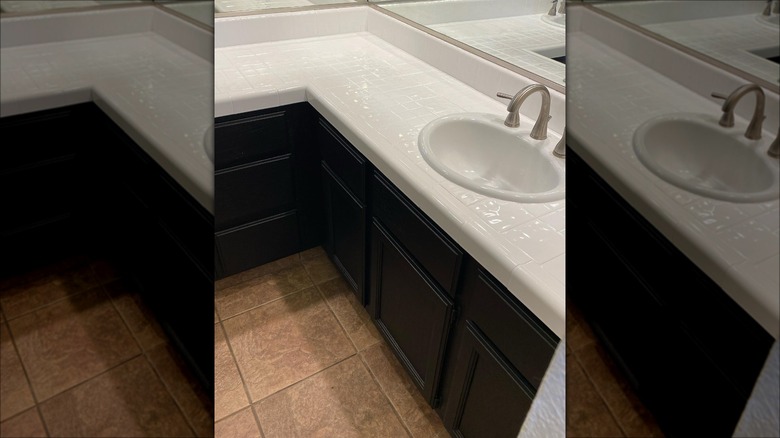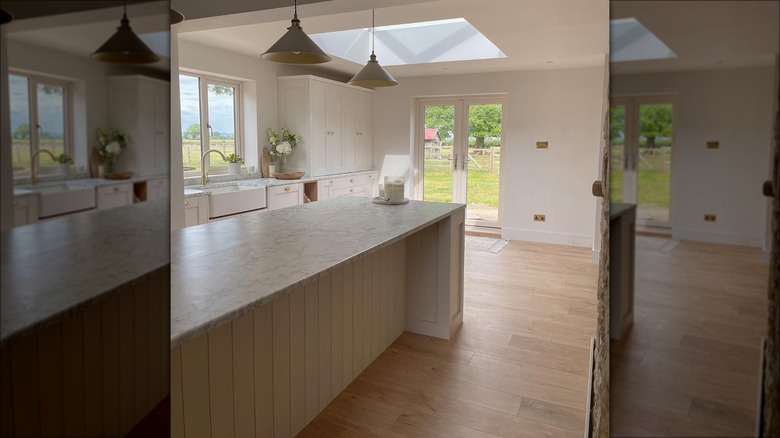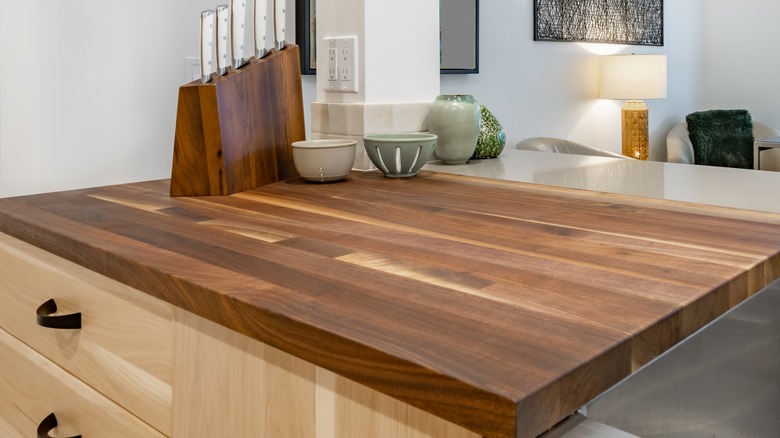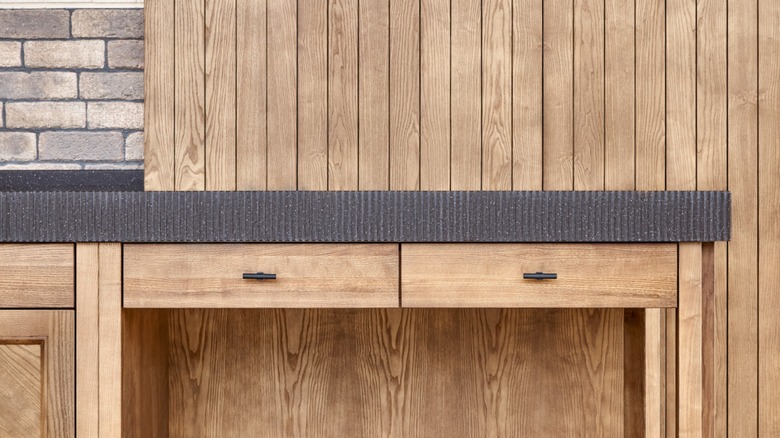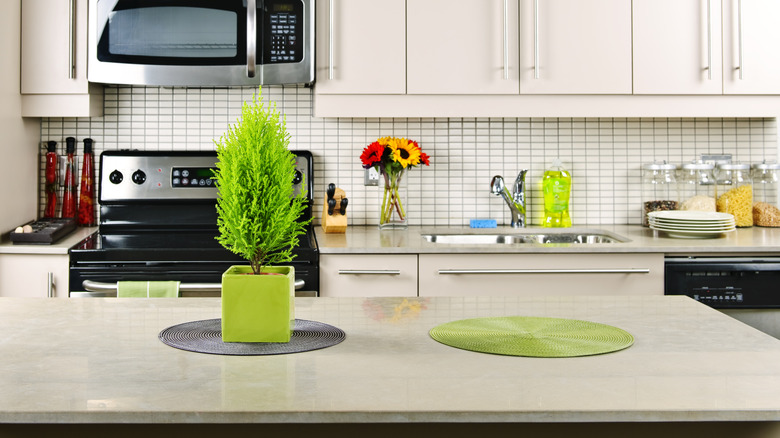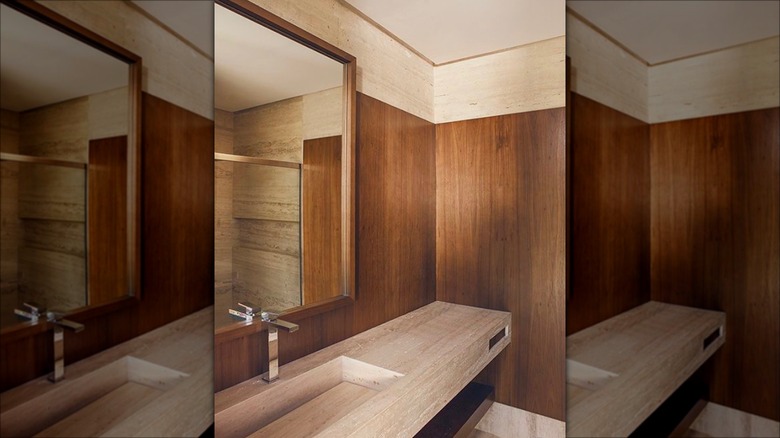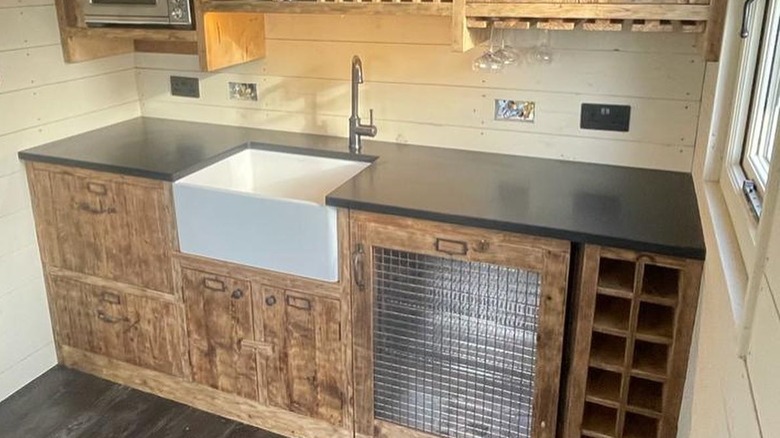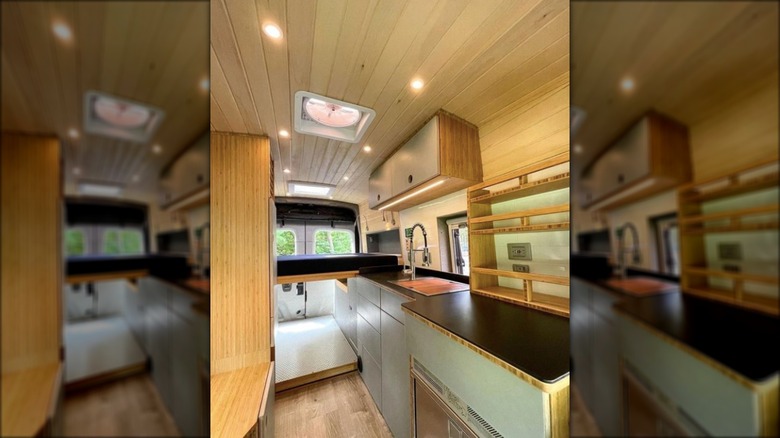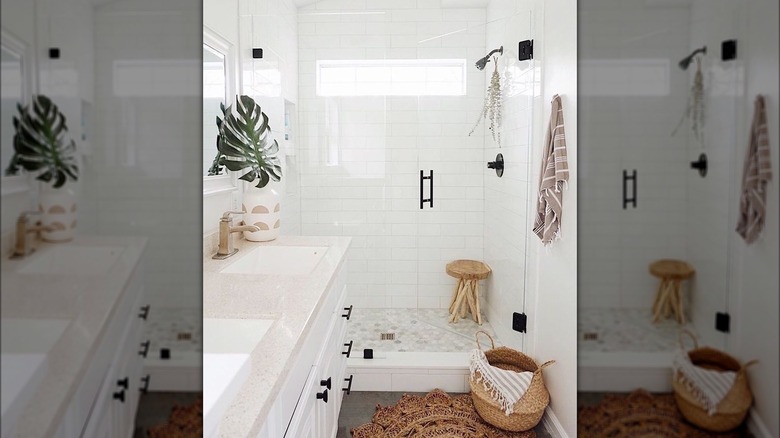These Are The Most Affordable Countertop Materials People Actually Buy
Quartz and marble may rule the countertop world, but not everyone can afford these reigning queens. Luckily, there are multiple material alternatives to spruce up your kitchens and bathrooms without costing a fortune. Depending on your budget, non-negotiables, and aesthetics, you can choose from laminates, ceramic tiles, wood, porcelain tiles, limestone, and other options outlined below. That being said, it's important to note that inexpensive materials don't equal affordable countertops. This is because edging treatments, labor costs, refinishing, and cutout (sink, electrical, faucet, or cooktop) installations can add up to a considerable sum. You might also have to fork out money to remove old countertops if you're replacing them or renovating your home anew.
On average, you can expect to pay anywhere between $1864 and $4388 for new countertop fittings (via Angi). Obviously, these are mere estimates, and you could very well sit at the lower end based on the worktop's size, type of countertop material, and installation method (DIY or contractor). Your location may also come into play, as easy access or lower transportation costs drive down material prices. So, shop around for different quotes and material grades to stay under budget. Also, if you've got the skills and believe the chosen material is sufficiently durable, consider setting up the countertops on your own while sticking to standard edges.
Laminate countertops: diverse styles at a budget
Don't write off laminates, even if they remind you of the '50s and '60s. Made from resin-soaked kraft papers that are heat-compressed and pasted to particle board after curing, laminate sheets are your go-to when functioning on a shoe-string budget. But how much can you expect to spend on laminate countertops? Per Angi, it could cost you between $8 and $27 per square foot, although Formica's stocks are priced higher, ranging from $40 to $80 per square foot. It could, of course, cost you less if you buy laminate sheets from the home center and DIY the installation. Make sure to slice the sheets with a cutting board to avoid scratching them. Moreover, as they mimic several styles, textures, and looks, including wood, marble, and stainless steel, you get plenty of ways to make laminate countertops work for your kitchen and bathroom.
But if you don't want to risk DIY, choose pre-laminated slabs that you can have the pros install in under a few hours. The downside is your options could be limited unless you don't mind waiting for a custom fit. Although laminates get a bad rep for getting easily scratched, stained, and damaged, their high-pressure laminate variants are more durable (with a price to match). Sealants help, too. Although consistent water exposure may delaminate them anyway, calling for frequent replacement. That being said, they're easy to maintain, requiring only soapy water to wipe them clean.
Ceramic tile countertops: perfect for light usage
Another 20th-century darling, ceramic tiles are seeing a resurgence, and justly so. They offer a host of colors, sizes, and shapes that harken back to rustic, country, or French designs at a highly affordable price point. Angi estimates you could get ceramic tiles for under $15 per square foot, with the cheapest ones going for a mere dollar for every square foot. Glazed over post-kiln firing, ceramic tiles are mostly crafted from clay and other earthy rudiments. However, they're easy to paint over if you wish to give off an industrial or retro look. Straight-fitted square tiles give off a sleek vibe. Although heat resistant, overly high temperatures can cause the tiles to crack.
Since spills, food debris, and splashes are a foregone conclusion in a kitchen (unless you prefer ordering takeout most of the time), cleaning the tiled countertop's seams can be a tall task, dissuading many DIYers. Sealants can minimize the issue, as can fitting dark-colored, stain-proof grouts. You should also look for water-resistant, flat-profile tiles so grime doesn't accumulate easily. Otherwise, be ready to invest in a cutting board. Remember, the bigger the tiles, the fewer the seams, so pay attention to the grout-tile ratio to maintain a hygienic kitchen. The best part, though? You can breathe new life into your outdated tile countertops by painting them over or replacing their chipped tiles with new ones; just ensure you keep a few extra tiles handy.
Porcelain countertop: the trendiest but delicate food backdrop
From crockery and sinks to countertops, porcelain has truly become the kitchen darling. Selling at anywhere between $3 and $28 per square foot, this ceramic brother is produced similarly by subjecting kaolin (white clay), feldspar, quartz, and mica to over 2600 degrees Fahrenheit, lending it its characteristic glazed look. Such high temperature blazing makes porcelain dense, significantly raising its durability and heat resistance. Indeed, it beats the likes of granite and sandstone on the Mohs hardness scale (strength test). But don't test it out with blunt objects like meat cleavers or hammers; your porcelain won't survive them.
Moreover, stains (including acidic substances) are a no-issue if the countertop is top-dressed with glaze since it reduces the material's porosity. It can also tolerate the sun without discoloring, making it perfect for outdoor barbecues. Its biggest advantage lies in how, at first glance, it passes off as marble, although its patterns can be changed to resemble other designs, such as wooden countertops. This probably explains why some of your favorite HGTV stars, including Egypt Sherrod, vouch for it.
However, you should think twice before installing porcelain countertops. These delicate beauties can snap during slab cuttings, necessitating professional help rather than going down the DIY route. Labor charges can add another $10 to $20 per square foot to the countertop costs, pushing it out of range for some homeowners. They're also limited in their edge options, mostly bearing square rims.
Butcher block countertop: to achieve a rustic charm
Combining and shaping several wooden strips into a solid slab, butcher block countertops add a timeless warmth to the heart of your home. Ranging between $20 and $70 per square foot, their material costs vary significantly depending on the grain used. Birch and red oak are priced lower than other hardwood varieties, consisting of teak, walnut, and maple. Although grass, bamboo-based countertops are in this category for their woody resemblance. Butcher blocks are attractive because they're eco-friendly and recyclable. While not many market offerings are made from reclaimed wood, they're catching up, given the sustainability wave. Besides, they can hold up for over 20 years, which is brilliant for all the budget-conscious homeowners who don't want to bother with frequent remodeling. However, you'll have to sand it down occasionally to take care of any knicks, scorch marks, dents, and scratches.
While butcher block countertops are great for their variety, color, patterns, and grain styles that can accommodate a plethora of interior design styles — from cottage core to farmhouse — they've got their downsides. They're prone to cracking as they expand and contract when the temperature fluctuates. Installing them around ⅛ inch further than the walls should give them sufficient breathing space. They also need frequent sealing to maintain their durability and deal with water damage or burn marks. While you can install them on your own, it isn't advised because wood can be heavy, leading to accidents.
Solid surface countertop: a choice for the bold
A classic example of economics at play, solid surface countertops jumped down on the price list when DuPont's patent for the stone simulating material ("Corian") expired. Although Corian kitchen countertops are still considered mid-tier, going up to $75 per square foot in some cases, its competitors have saturated the market with inexpensive acrylic options priced between $13 and $30 per square foot (via Angi). They're quite a find for bold homeowners who love experimenting with esoteric shades and colorful patterns instead of sticking to the staid neutral tones common with most other countertop types.
As solid surface material is made from marble-cut mineral dust and acrylic with some resins and pigments added, they're silky smooth and solid, making them a cut above flimsy laminates. They're polyester-based surface materials that are priced lower yet offer better colors. However, unlike acrylic, they're unsuitable for thermoforming. These countertops' solidity denotes their continuous, expansive look that cleverly hides all seams—assuming pros installed them. Being near non-porous, they're effective at combating bacteria and stains, keeping high-traffic kitchens sanitary. However, you'd be better off adding a cutting board to your kitchen's arsenal, as these countertops don't take well to knife action. Exposure to temperatures exceeding 250 degrees Fahrenheit can leave them deformed. Luckily, they're a breeze to repair with some fine grit sandpaper.
Soapstone countertops: for an antique look
Don't be fooled into thinking soapstone countertops are soft because of their name or association with sculptures. These talcum-containing metamorphic rocks have been kitchen mainstays for a long time, initially used as cooking pots and now as countertops. However, kitchen counters use construction-grade stone with a lower talc concentration because if it goes over 50%, it won't be sturdy in busy kitchens. Angi estimates you can buy soapstone materials for anywhere between $20 and $70 per square foot, depending on talc content and color novelty. In its natural state, soapstone is gray-toned, giving off an antique vibe, which explains why it graces the outdoor patio kitchen of Stanley Tucci. Rarely, they also come in marble-white shades with bluish-green undertones and varied vein designs, albeit with a bigger price tag.
Its aging is a double-edged sword, leaving some homeowners with mixed feelings about soapstone countertops. Since it's prone to oxidizing, soapstone darkens over time (patina), which wouldn't be a problem if you prefer waxing or oiling your countertop every month to achieve an aged look. But it'll get annoying every time you scratch or spill oil and acidic substances on the countertop because it leaves the patina uneven despite not staining. You can reset it, though, with a little sanding. That being said, soapstone is stronger than marble and granite (fewer chipping woes) and bests quartz in heat resistance, making it a great natural stone choice if it fits your budget.
Travertine countertops: go chic for the win
Eponymous of Tivoli, an Italian town housing most travertine deposits, travertine countertops are your go-to for a luxe-looking bathroom. Made of recrystallized calcium carbonate, it belongs to the limestone family and is treasured for its earthy look. Since it's mined naturally (which also makes it eco-friendly), no travertine slab is alike, with every stone exhibiting its unique pattern of pits, veins, and perforation. Mostly colored beige, travertine also appears in cream, walnut brown, ivory, and coral tones. It's generally priced in the range of $11 and $35 per square foot (per Angi). Travertine's biggest draw lies in its customization. It resoundingly defeats porcelain tiles when it comes to reshaping the stone into irregular shapes that fit in with the room's layout and aesthetics. This doesn't, by any means, imply that travertine countertops aren't durable—they are and can withstand sufficient load pressure. But there are some pitfalls, too.
Travertine takes unkindly to spillages and is quick to show unsightly stains. It even etches when exposed to lime juice, vinegar, tomato sauce, or other acidic liquids. This also means abrasive cleaners are a no-go on these gorgeous countertops. Naturally, such heavy maintenance requirements make it a poor fit for heavy kitchen usage unless you install higher grades that offer more durability. Additionally, you'll have to seal them regularly to minimize damage. A glossy finish may further lower the material's porosity, although chipping and denting will remain a cause for concern.
Slate countertops: dark stones for visual drama
Although not the cheapest option on the list, slate fits the bill compared to its pricier stone ilk of granite and marble, imported rather than quarried locally. It can go up to $90 per square foot, with the cheapest options costing around $30 for the same area. Installing slate tiles in place of slabs is generally more cost-effective. Although slate countertops have a lot going for them, their aesthetics play a key role. Fashioned out of quartz or other similarly mineralized rocks, slate exhibits numerous shades of gray that complement the much-coveted modern designs. They can also harmonize a monochromatic or rustic home design. You can get more color play with tiles since they come in green, copper, purple, and amber hues.
Slates are beasts in terms of durability. You only need to look at long-standing European roofed buildings, especially German cathedrals, for proof. They are impervious to water damage, with their absorption rates falling under 0.5%. Still, it's best to seal them every six months or so to prevent discoloration or chemical burns that happen when you mistakenly clean your slate with acidic cleaners. Avoid soap, as its organic compounds react with slate to line it with film. They're slip-resistant, too, making them great around naughty kids and pets who treat countertops as their dance floors but make sure to round off their edges.
Paper composite countertops: when sustainability reigns supreme
A renewable and modern alternative to granite countertops, paper composite countertops are another mid-tier price option that sell for around $30 per square foot. Sometimes passing off as soapstone, they are made into thin sheets by baking pigment and resin-saturated papers (originally due for landfills). In other words, they're made of 100% recycled paper. You aren't off the mark if you sense an uncanny resemblance between their production process and laminates'. The difference is that they are far more durable—even surpassing wood. Nevertheless, their manufacturing does leave scope for more. They are available in limited colors, considering their raw material turns yellow when dry. So, lighter shades like white and creams are hard to come by, diminishing their reflectivity. However, its main sellers (Paperstone and Richlite) sell a plethora of dark-tinted slabs.
Paper composites are also limited in their finish. While they look good as matte, glossy polish warps their surface. However, you can save on installation costs, as they behoove themselves to DIY, as long as you know how to work your woodworking tools. While it is stain and water-resistant, it won't withstand heat (over 350 degrees Fahrenheit) or UV damage, so avoid putting hot pots over it and restrict its outdoor usage in hot climates. It's easy to maintain and can be wiped clean with soap. But you must seal it regularly, as it scratches easily. Like soapstone, it too develops a patina as it ages.
Cultured granite: when you desire a granite look
If you love the mien of granite countertops but aren't up for the investment, cultured granites are a suitable alternative. Unlike faux granite finishes and embossed laminates, cultured granite countertops closely replicate natural granite stones down to their deepest layers. They are manufactured by fusing recycled stone bits, colorful chips, and polyester resin, and later gel-coated to give off a sleek, uniform, burnished look. Once the polymers have hardened in their molds, they are removed, cut down to size, and expertly polished. According to Marble.com, the cheapest variants are available for $30 per square foot, with the high-end options selling for $50 per square foot.
Cultured granite countertops are suitable for homeowners who are tardy with maintenance. As is known, natural stones require frequent sealing to keep them up to the mark, which isn't the case with cultured granite since they're non-porous, given they are mass-engineered. Moreover, in sharp contrast to natural granite, they offer several unique shapes and shades, making for a more personalized look. Unfortunately, they aren't as abrasion-proof as their stone counterparts. This is because their gel coating is made of soft plastic that wears down quickly when the countertop is scrubbed down. Besides, its luster cannot be restored once it's gone, necessitating replacement.
